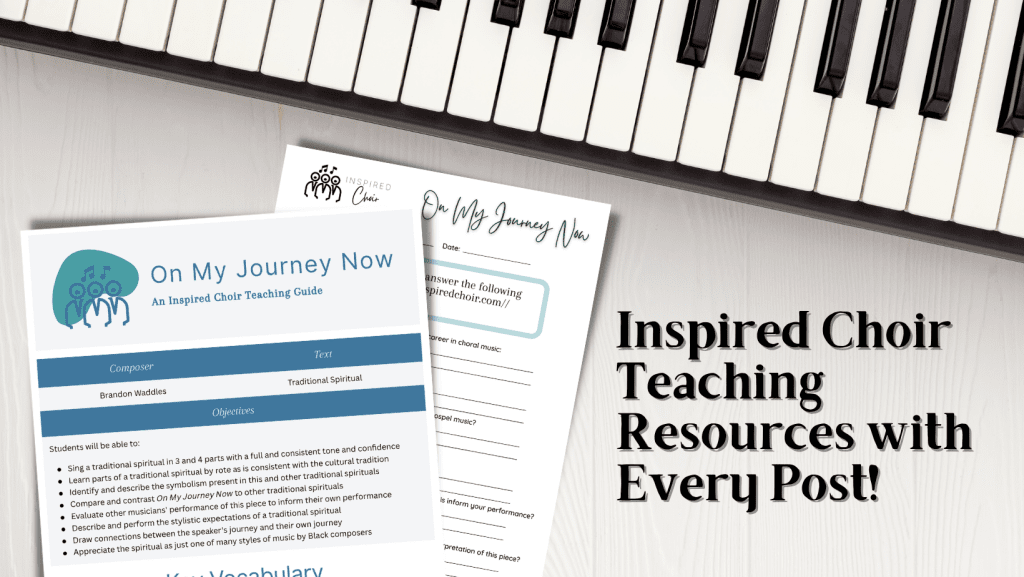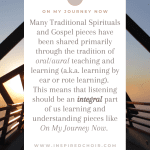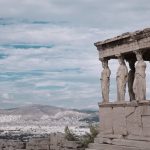Get to Know On My Journey Now Arranged by Brandon Waddles
On My Journey Now arranged by Brandon Waddles is a joyful gospel interpretation of a traditional spiritual. With characteristics of both gospel and spirituals, this piece provides an excellent introduction to both styles of music, and opens the door to discussion of symbolic language in spirituals and to listening opportunities galore. In this week’s post, I examine the following aspects of On My Journey Now as arranged by Brandon Waddles.
- Arranger Brandon Waddles
- Traditional Spirituals and Gospel Music
- Symbolic Language in On My Journey Now
- Must-Listen Recordings
- On My Journey Now Teaching Resources
Before reading on, take a listen here to On My Journey Now by Brandon Waddles.

Said I’m On My Journey Now!
Last year, our treble ensemble performed Still I Rise by Rosephanye Powell (highly recommend) and absolutely loved it. When we began this year, many of our returning singers listed that piece as representative of their favorite choral music to sing. Cue to me searching diligently for another quality SSA gospel-style arrangement to feature this year.
On My Journey Now arranged by Brandon Waddles proved to be the perfect arrangement for our ensemble this semester. Below, I share a bit about arranger Brandon Waddles, the differences between traditional spiritual and gospel musics, the symbolic language present in On My Journey Now, and must-listen recordings of the traditional spiritual.
Arranger Brandon Waddles
Through his career, composer, arranger, scholar, music director, and conductor Dr. Brandon Waddles has shown the variety of musical work that can be done in the choral world. Calling his career “a great zig-zag” in a recent episode of The Career Musician, Waddles has proven that there is not one way to pursue a career in choral music.
Dr. Waddles’s journey included formative musical experiences in Detroit with his father, education at Morehouse College, Westminster Choir College, and Florida State University, and faculty positions at Westminster and Wayne State University.
Additionally, Dr. Waddles composed and arranged music that has been performed around the world, musical directed for Grammy-nominated recording artist Ledisi, music ministered at several churches, and completed research on spirituals, gospel music, and the life and work of Thomas Whitfield.
Want to listen to more of Dr. Waddles’s work? Here are a few pieces I love:
- Westminster Chapel Choir’s performance of “Cert’n’y Lord” with Waddles himself accompanying
- The Choir School of Delaware’s performance of “I Shall Wear a Crown” by Thomas Whitfield and transcribed by Dr. Waddles
- Spire Chamber Ensemble’s performance of “He’s Got the Whole World in His Hands”

Traditional Spirituals vs. Gospel Music
Although they are developmentally related genres, Traditional Spirituals are distinct from Gospel Music. Explaining the difference, historian Horace Clarence Boyer said “Spirituals spoke to the community; gospel speaks to one person.” Both styles are relevant to the discussion of On My Journey because this piece is a traditional spiritual with a gospel arrangement.
Traditional Spirituals
Spirituals are religions folksongs, largely created in the late 18th and 19th centuries by enslaved individuals. Inclusive of work songs, sing songs, sorrow songs, and freedom songs, spirituals shared biblical stories and described the extreme hardship that enslaved African Americans endured. Originated in oral tradition (passed by speaking or singing), spirituals were originally unaccompanied and monophonic (no harmonies), often with slow tempos, improvisation, and call and response moments.
The Fisk Jubilee Singers, a small group of college singers, popularized traditional spirituals on choir tours in the late 19th century. In the early 20th century, composers Harry Burleigh, Robert Nathaniel Dett, and William Dawson brought spirituals to concert settings, arranging them with a classical form.
For more information on traditional spirituals, here are a few great resources:
- The Spirituals Database
- NegroSpirituals.com
- Black Music Scholar: History of Negro Spirituals and Folk Music
Gospel Music
Gospel Music is a descendent of spirituals and the blues that originated in the early 20th century. Known for its rhythmic, euphoric, and spiritual characteristics, Gospel Music composers broke barriers by incorporating elements of jazz, blues, and ragtime music in a church setting.
Important figures in the popularization of gospel music include the “Father of Gospel Music,” Thomas A. Dorsey and the “Queen of Gospel,” American singer Mahalia Jackson. Starting their work together in Chicago, these two musicians performed Gospel music around the United States.
A precursor to R&B music, gospel music eventually became a mainstream genre in the 1950s and 1960s. The prolific singer Aretha Franklin and her utilization of gospel style within her music had a lot to do with this popularization.
For more information on gospel music, check out these great resources:

Symbolic Language in On My Journey Now
Traditional spirituals often included symbolic or coded language within their lyrics. These codes allowed for moments of secret communication between enslaved people. Often, the codes referred to escaping to freedom. As Rev. Velma Maia Thomas said, “The words we’re saying have a double meaning. So, anytime you hear anything about traveling shoes or chariots or wheels, somebody’s getting ready to run.”
Songs like “The Gospel Train” and “Swing Low, Sweet Chariot” refer to the underground railroad. Harriet Tubman’s codename was Moses, and she used the song “Go Down, Moses” to communicate with those individuals she was helping. Any discussion of “Jordan” or “The Promised Land” or “Zion” referred to the northern side of the Ohio River. “Follow the Drinking Gourd” is about following the North Star to freedom and “Wade in the Water” instructed those being chased to Wade in the Water so dogs could not trace their scent.
It is likely, then, that the lyrics of On My Journey Now (that include descriptions of walking and journeying and Mount Zion) are symbolically referring to an escape to the North. Do you agree? Let me know in the comments below!
Must-Listen Recordings
Many Traditional Spirituals and Gospel pieces have been shared primarily through the tradition of oral/aural teaching and learning (a.k.a. learning by ear or rote learning). This means that listening should be an integral part of us learning and understanding pieces like On My Journey Now.
Below are a few must-listen recordings to help gather context for On My Journey Now:
- Start with the Waddles arrangement here.
- Then, watch to mezzo soprano Florence Quivar performing the spiritual here. Her short interview following her performance is also great.
- Next, listen to Paul Robeson here and Ruby Elzy here.
- Check out another gospel choral interpretation of the traditional spiritual with Shirley Ceasar’s “I Wouldn’t Take Nothing” here.
Each performance of the spiritual offers us stylistic interpretations that may inform the way we decide to craft our performance of the piece. Are there any other recordings we should add to this list? Let me know in the comments below!

Complementary Pieces
Want to listen to other pieces like On My Journey Now? Or planning a concert and need some programming ideas? Here are a few complementary pieces!
Enjoying the Journey Theme? Check out these pieces:
- The thoughtful text of I Am Leaving by Miriam Sonstenes explores the challenges of leaving those you love.
- Philip Silvey’s Flying Solo envisions the process of gathering courage to embark on a new stage in life.
- With sweet melodies, charming text, and approachable harmonies for choirs of all voicing types, Fly Away Home by Pinkzebra explores the meaning of home when away.
Other Pieces I’ve Programmed With On My Journey Now this concert cycle:
- My Heart Be Brave by Marques Garrett
- Algo Me Dicen Tus Ojos by Rosephanye Powell (Post Coming March!)
- Say Her Name by Alysia Lee
- Here’s the whole “How Sweet the Sounds” Repertoire Roundup
I’d Love to Hear from You!
Have you sung or conducted On My Journey Now with your choir? What other Brandon Waddles pieces do you love? What gospel or spiritual pieces should we feature on the blog? How did your choirs respond to the text and message of the piece? Let me know in the comments below!
On My Journey Now Teacher Resources!
FREE On My Journey Now Reading Comprehension Worksheet
Reading Comprehension Worksheets pull five key points from the blog post above. Additionally, they ask singers to consider musical decisions they can make with the info from this post. Fill in the form below and get a link to a folder including the On My Journey Now worksheet and all 2023 Jan/Feb post worksheets.
On My Journey Now Teaching Guide
Check out the Inspired Choir Shop for the On My Journey Now Teaching Guide, which includes the following:
- Learning objectives specific to On My Journey Now
- Key Vocabulary and Definitions
- Discussion Prompts
- Three Learning Activities
- Suggested Teaching Sequence
- Additional Teaching Resources

Looking for an On My Journey Now Lesson Plan Bundle? Send a request to hello@inspiredchoir.com!

















